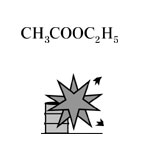| Case Name |
Explosion during cleaning by brushing a tank for dangerous materials at a paint manufacturing factory |
| Pictograph |

|
| Date |
January 30, 1995 |
| Place |
Hirakata, Osaka, Japan |
| Location |
Chemical factory |
| Overview |
On January 30th, 1995. An explosion occurred on cleaning a tank in a paint factory. Cleaning was done to change the contents of the tank. Ethyl acetate was put in three days after the paint was removed. The tank was left for three days without cleaning, and it was scrubbed with a brush having a long handle. The ethyl acetate vapor exploded due to static electricity generated by brushing. One worker received a burn on the face. Usually, cleaning was carried out just after drawing-off. Three days passed this time, and the paint solidified. Then, brushing was done many times. The accident happened because a static electricity spark was generated in a combustible solvent environment. Sufficient management of static electricity was necessary for this cleaning operation which was highly dangerous. |
| Incident |
A premix tank at a paint factory was being cleaned. Ethyl acetate was put into the tank, and an explosion occurred during the cleaning operation in the tank. One worker received a burn on the face. It is considered that the fire was started by static electricity in the brush used for cleaning. |
| Processing |
Manufacture |
| Individual Process |
Maintenance |
| Substance |
Ethyl acetate, Fig2 |
| Type of Accident |
Explosion |
| Sequence |
On January 27th, 1995. The tank was emptied and left.
10:00 on January 30th. Tank cleaning started. 50 L of ethyl acetate was put into the tank, which was 1300 mm in inner diameter, and it was scrubbed with a brush. Cleaning was not finished.
(Time indistinct). 50 L of ethyl acetate was put into the tank again, and left for three hours. The tank became wet.
(Time indistinct). Residual ethyl acetate was put into a container, and the side wall was washed for five minutes with a small brush, and adhered material was removed. The bottom plate was scrubbed with a brush and ethyl acetate.
14:21. An explosion occurred when the bottom plate was scrubbed. |
| Cause |
This tank was left in an unclean condition after the paint was removed three days before the accident. The paint adhered and solidified at the tank bottom before cleaning. Ethyl acetate was used for cleaning. The paint, which solidified at the tank bottom, was rubbed strongly and repeatedly. It is considered that the brush was charged with static electricity and vapor generated from the solution was ignited by a spark.
Usually, the cleaning was executed just after the empty operation of the tank. During three days, the solvent of the paint vaporized and solid components of the paint adhered and solidified. |
| Response |
The fire was extinguished with two fire extinguishers. |
| Countermeasures |
The accident occurred even though some preventive measures were taken against static electricity. An inspection must be made on static electricity prevention measures. Education must be carried out to improve the knowledge of employees on static electricity.
Also, the paint adhered and solidified at the tank bottom has to be cleaned just after emptying the tank. This must be added to the safety regulation. |
| Knowledge Comment |
A cleaning operation using a combustible solvent is accompanied by the danger of ignition. It is necessary to carry out sufficient safety management such as taking countermeasures against static electricity. |
| Background |
After the paint was removed from the tank, the tank was left in an unclean condition for three days. The manager and the workers did not know the reason why the cleaning was executed just after the tank became empty. A lack of knowledge is the true cause of the accident.
They seemed not to consider the combustibility of ethyl acetate. In spite of using the combustible liquid, the managers allowed brushing without any confirmation of effectiveness of anti-static electricity countermeasures. Obviously there must be a deviation from the safety standard. |
| Reason for Adding to DB |
Example of explosion during cleaning a tank for dangerous materials |
| Scenario |
| Primary Scenario
|
Poor Value Perception, Poor Safety Awareness, Inadequate Risk Recognition, Organizational Problems, Poor Management, Slackness of Management, Carelessness, Insufficient Precaution, Mannerism, Planning and Design, Poor Planning, Poor Planning of Washing Schedule, Regular Movement, Careless Movement, Repetition of Friction, Secondary Damage, External Damage, Explosion, Bodily Harm, Injury, 1 peson burnt
|
|
| Sources |
Fire and Disaster Management Agency and major cases of accidents. Explosion at a manufacturer when cleaning a dangerous material tank. Accident cases of dangerous materials. pp.24, 72-74.
|
| Number of Injuries |
1 |
| Physical Damage |
50 L of ethyl acetate in an indoor tank burned. 50 L of ethyl acetate was lost. |
| Financial Cost |
¥ 11,000 (Accident cases of dangerous materials) |
| Multimedia Files |
Fig2.Chemical formula
|
| Field |
Chemicals and Plants
|
| Author |
DOBASHI, Ritsu (School of Engineering, The University of Tokyo)
TAMURA, Masamitsu (Center for Risk Management and Safety Sciences, Yokohama National University)
|
|